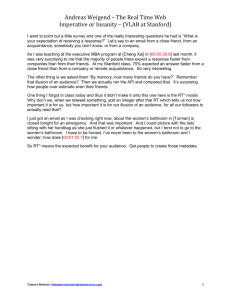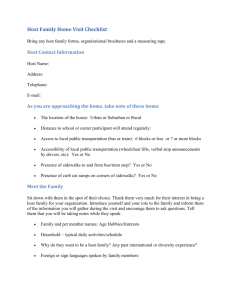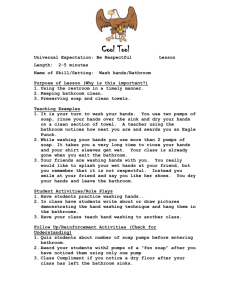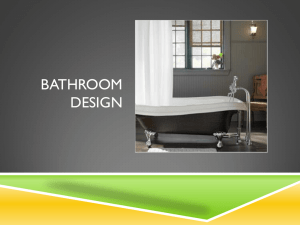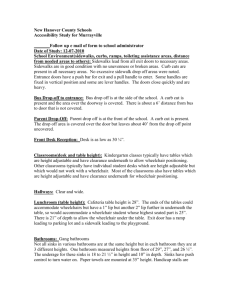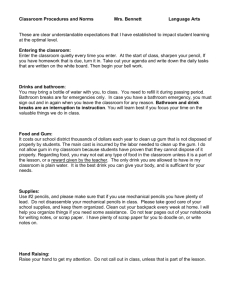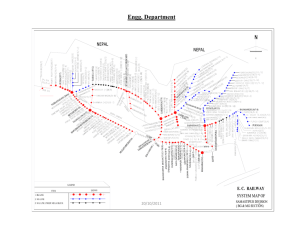Accessibility-Disabled Access checklist
advertisement
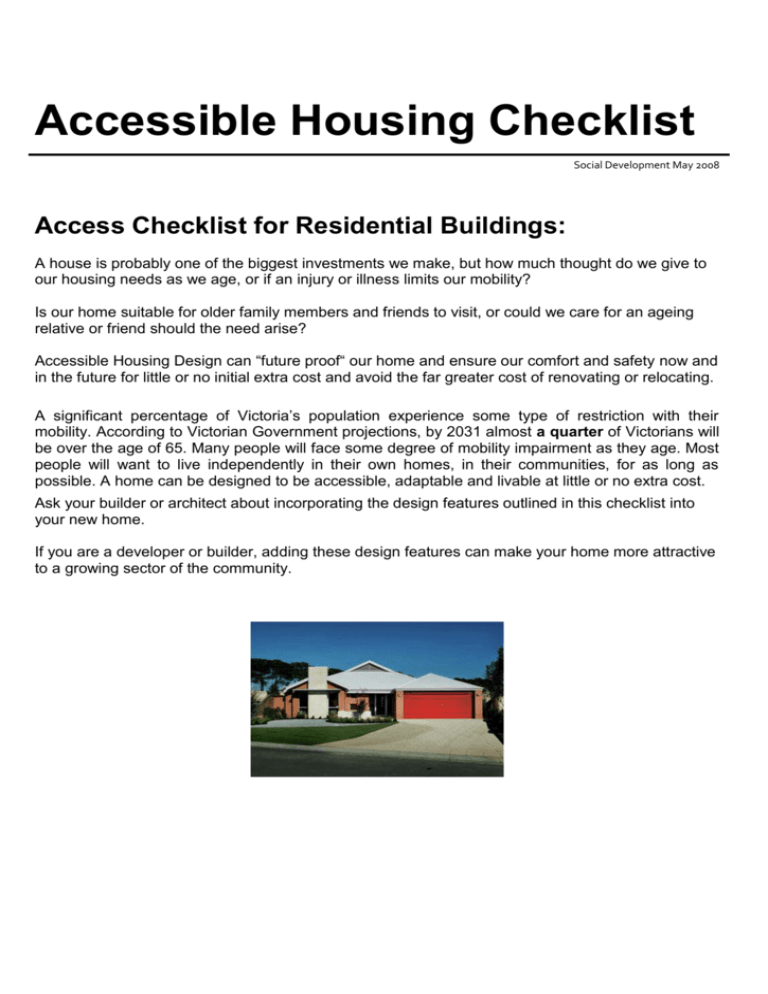
Accessible Housing Checklist Social Development May 2008 Access Checklist for Residential Buildings: A house is probably one of the biggest investments we make, but how much thought do we give to our housing needs as we age, or if an injury or illness limits our mobility? Is our home suitable for older family members and friends to visit, or could we care for an ageing relative or friend should the need arise? Accessible Housing Design can “future proof“ our home and ensure our comfort and safety now and in the future for little or no initial extra cost and avoid the far greater cost of renovating or relocating. A significant percentage of Victoria’s population experience some type of restriction with their mobility. According to Victorian Government projections, by 2031 almost a quarter of Victorians will be over the age of 65. Many people will face some degree of mobility impairment as they age. Most people will want to live independently in their own homes, in their communities, for as long as possible. A home can be designed to be accessible, adaptable and livable at little or no extra cost. Ask your builder or architect about incorporating the design features outlined in this checklist into your new home. If you are a developer or builder, adding these design features can make your home more attractive to a growing sector of the community. Some recommended design features. Accessible Path of Travel: A clear path of travel from the boundary of the property to the front door should be provided. A gradient greater than 1 in 20 is too steep for safe use by anyone a with mobility impairment. Where possible steps should be avoided. Entry The entry to a residence should be level. This includes having no step and a lip free entry. Access to the entry may be ramped, but with a gradient no greater than 1 in 14. *To calculate 1 in 14, multiply the vertical height between levels by 14. This will give you the length of ramp needed for a gradient of 1 in 14. The same formula applies to alternative gradients (1 in 20 etc) Hand Rails For ramps it is recommended that handrails be fitted on both sides. Rails should be fitted between 865mm – 1000mm off the ground and extend a minimum of 300mm beyond the end of the ramp. Because handrails are at head height for children the ends should be turned down through 180 degrees or to the ground to avoid injury. Doors and Doorways Openings of doorways should be at least 850mm. This means that the actual clearance of the door (the inside measurement), not just the door itself should be 850mm. To reach this width, hinged doors should be 870mm wide. Where sliding doors can be installed, these may provide better accessibility. Layout and Circulation Space The entry level (usually the ground floor) of a dwelling should have a food preparation area, bathroom, toilet and bedroom, all of which can be accessed by a person in a wheelchair. Refer to AS 1428.1 and AS 1428.2 for more details of accessible bathrooms. See attachment 1 for an example of a combined accessible bathroom/toilet. Layout and Circulation Space Continued… All rooms, when furnished or fitted out, should have enough space for a person using a wheelchair to move around. Obviously spaces and dimensions of rooms vary from one home to another. See the Victorian Building Commission’s Welcome Guide for examples and further information www.buildingcommission.com.au Corridors and Passageways Corridors should be at least 1000mm wide. To provide access to 850mm doorways from a corridor, the width of the corridor should be increased to 1200mm. This will allow residents to travel comfortably in and out of rooms adjoining corridors and passageways. For apartment blocks with common corridors, a minimum 1200mm is required with sections for passing at 1800mm by 2000mm in length to provide good access. Bathroom There are a variety of accessible bathroom designs which allow enough circulation space for a person using a wheelchair/scooter to access facilities. If your toilet and bathroom are separated by a wall, making provision for the removal of this wall may allow you to create a wheelchair accessible toilet later. *See attachment 1 for an example of a combined accessible bathroom/toilet. Fittings Door handles, switches, and power points should be within reach of and can be used by all potential users. As a guide powerpoints and light switches should be 500mm from an internal corner and between 900mm and 1100mm high (See AS 1428.1 & .2 for further details). Letter and power boxes should be positioned in an area and at a height that is easily accessible to all users. Allow for Changes If the dwelling has two or more stories or levels ensuring there is space to install a wheelchair accessible lift in the future will provide an accessible and adaptable home for the long term. Walls and ceilings should be reinforced when building a home to enable the future installation of handrails or hoists. Higher Density Residential Dwellings Considering the full range of accessibility features in multi unit developments increases the marketability of these developments for current and future residents. Council recommends that an accredited Access Consultants report be obtained and presented to Council when submitting planning and building applications for developments of 10 or more dwellings. For details of accredited access consultants go to the Association of Consultants in Access Australia website www.access.asn.au/ Accessibility Checklist Accessible path of travel from property boundary to front door Level and step free entry 1 in 14 gradient ramp to entry 850mm clearance at all doorways Minimum 1000mm wide internal passageways 1200mm and 1800mm x 2000mm passageways for shared and common corridors Light switches and power points 500mm from internal corners and 900mm 1100 high Reinforced ceilings and bathroom walls for future handrails This checklist is a guide only and does not cover all considerations when designing a home. Councils Building Services Branch and Urban Planning Branch will be able to assist you with further enquires and suggestions to design accessibly. For further technical information refer to the Victorian Building Commissions Welcome Guide or Australian Standards 1428.1,1428.2 and 4299. This checklist has been developed by Bill Lawler, Rural Access Project Officer La Trobe City and Shawn Neilsen, MetroAccess Project Officer, Moreland City Council. Rural Access and Metro Access are initiatives of the Department of Human Service, Building Inclusive Communities. More information and useful websites. www.standards.com.au for copies of Australian Standards www.vicurban.com.au for examples of accessible housing Building Commission PH: 9285 6400 or www.buildingcommission.com.au The Centre for Universal Design www.design.ncsu.edu/cud Department of Family and Community Services PH: 8626 1134 or www.facs.gov.au Property Council of Victoria PH: 9650 8300 or www.propertyoz.com.au Australian Building Codes Board PH (02) 6213 7240 or www.abcb.gov.au Attachment 1:
